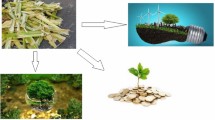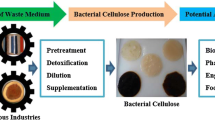Abstract
During the pretreatment and hydrolysis of lignocellulosic biomass to obtain a hydrolysate rich in fermentable sugars, furaldehydes (furfural and hydroxymethylfurfural), phenolic compounds, and organic acids are formed and released. These compounds inhibit yeast metabolism, reducing fermentation yields and productivity. This study initially confirmed the ability of Spathaspora passalidarum to ferment xylose and demonstrated its sensibility to the inhibitors present in the hemicellulosic sugarcane bagasse hydrolysate. Then, an adaptive laboratory evolution, with progressive increments of hydrolysate concentration, was employed to select a strain more resistant to hydrolysate inhibitors. Afterward, a central composite design was performed to maximize ethanol production using hydrolysate as substrate. At optimized conditions (initial cell concentration of 30 g/L), S. passalidarum was able to produce 19.4 g/L of ethanol with productivity, yield, and xylose consumption rate of 0.8 g/L.h and 0.4 g/g, respectively, in a sugarcane bagasse hemicellulosic hydrolysate. A kinetic model was developed to describe the inhibition of fermentation by substrate and product. The values obtained for substrate saturation and inhibition constant were Ks = 120.4 g/L and Ki = 1293.4 g/L. Ethanol concentration that stops cell growth was 30.1 g/L. There was an agreement between simulated and experimental results, with a residual standard deviation lower than 6%.



Similar content being viewed by others
Data Availability
The authors confirm that the data and materials supporting the findings of this article are available within the article and from the corresponding author (S. B. G.) upon reasonable request.
References
Mata, T. M., Tavares, T. F., Meireles, S., & Caetano, N. S. (2015). Bioethanol from brewers’ spent grain: pentose fermentation. Chemical Engineering Transactions, 43, 241–246
Oliva, J. M., Negro, M. J., Manzanares, P., Ballesteros, I., Chamorro, M. A., Sáez, F., Ballesteros, M., & Moreno, A. D. (2017). A sequential steam explosion and reactive extrusion pretreatment for lignocellulosic conversion within a fermentation-based biorefinery perspective. Fermentation, 3(2), 15. https://doi.org/10.3390/fermentation3020015.
Caetano, N. S., Moura, R. F., Meireles, S., Mendes, A. M., & Mata, T. M. (2013). Bioethanol from brewer’s spent grains: acid pretreatment optimization. Chemical Engineering Transactions, 35, 1021–1026
Bergmann, J. C., Trichez, D., Morais Junior, W. G., Ramos, T. G. S., Pacheco, T. F., Carneiro, C. V., Hororato, V. M., Serra, L. A., & Almeida, J. R. M. (2019). Biotechnological application of non-conventional yeasts for xylose valorization. In A. Sibirny (Ed.), Non-conventional yeasts: from basic research to application. Cham: Springer
Rodrussamee, N., Sattayawat, P., & Yamada, M. (2018). Highly efficient conversion of xylose to ethanol without glucose repression by newly isolated thermotolerant Spathaspora passalidarum CMUWF1-2. BMC Microbiology, 18(1), 73.
Kumar, A. K., & Sharma, S. (2017). Recent updates on different methods of pretreatment of lignocellulosic feedstocks: a review. Bioresource and Bioprocessing, 4(7), 7. https://doi.org/10.1186/2017/s40643-017-0137-9.
Almeida, J. R. M., Modig, T., Petersson, A., Hähn-Hägerdal, B., Lidén, G., & Gorwa-Grauslund, M. F. (2007). Increased tolerance and conversion of inhibitors in lignocellulosic hydrolysates by Saccharomyces cerevisiae. Journal of Chemistry, Technology and Biotechnology, 82(4), 340–349
Jeffries, T. W. (2006). Engineering yeasts for xylose metabolism. Current Opinion in Biotechnology, 17(3), 320–326
Morales, P., Gentina, J. C., Aroca, G., & Mussatto, S. I. (2017). Development of an acetic acid tolerant Spathaspora passalidarum strain through evolutionary engineering with resistance to inhibitors compounds of autohydrolysate of Eucapyptus globulus. Industrial Crops and Products, 106, 5–11
Nguyen, N. H., Suh, S. O., Marshall, C. J., & Blackwell, M. (2006). Morphological and ecological similarities: wood-boring beetles associated with novel xylose-fermenting yeasts, Spathaspora passalidarum gen. sp. nov. and Candida jeffriesii sp. nov. Mycological Research, 110, 1232–1241
Long, T. M., Su, Y.-K., Higbee, A., Willis, L. B., & Jeffries, T. W. (2012). Co-fermentation of glucose, xylose, and cellobiose by the beetle-associated yeast Spathaspora passalidarum. Applied and Environmental Microbiology, 78(16), 5492–5500
Veras, H. C. T., Parachin, N. S., & Almdeida, J. R. M. (2017). Comparative assessment of fermentative capacity of different xylose-consuming yeasts. Microbial Cell Factories, 16(1), 153
Hou, X., & Yao, S. (2012). Improved inhibitor tolerance in xylose-fermenting yeast Spathaspora passalidarum by mutagenesis and protoplast fusion. Applied Microbiology and Biotechnology, 93(6), 2591–2601
Soares, L. B., Bonan, C. I. D. G., Biazi, L. E., Dionísio, S. R., Bonatelli, M. L., Andrade, A. L. D., Renzano, E. C., Costa, A. C., & Ienczak, J. L. (2020). Investigation of hemicellulosic hydrolysate inhibitor resistance and fermentation strategies to overcome inhibition in non-saccharomyces species. Biomass and Bioenergy, 137, 105549
Nakanishi, S. C., Soares, L. B., Biazi, L. E., Nascimento, V. M., Costa, A. C., Rocha, G. J. M., & Ienezak, J. L. (2017). Fermentation strategy for second generation ethanol production from sugarcane bagasse hydrolysate by Spathaspora passalidarum and Scheffersomyces stipitis. Biotechnology and Bioengineering, 114, 10
Sluiter, A., Hames, B., Ruiz, R., Scarlata, C., & Sluiter, J. (2012). Templeton, and D. Crocker, NREL/TP-510-42618 analytical procedure—determination of structural carbohydrates and lignin in biomass. Laboratorial Analysis Procedure, 17. NREL/TP-510-42618
Haaland, P. D. (1989). Experimental design in biotechnology. New York: Marcel Dekker Inc
Ghose, T. K., & Tyagi, R. D. (1979). Rapid ethanol fermentation of cellulose hydrolysate. II Product and substrate inhibition and optimization of fermentor design. Biotechnology and Bioengineering, 21(8), 1401–1420
Yang, X. S. (2008). Nature-inspired metaheuristic algorithms. Luniver Press.
Lobato, F. S., & Steffen Jr., V. (2013). Multi-objective optimization firefly algorithm applied to (bio) chemical engineering system design. American Journal of Applied Mathematics and Statistics, 1(6), 110–116
Roeva, O. (2012). Optimization of E. coli cultivation model parameters using firefly algorithm. International Journal of Bioautomation, 16(1), 23–32
Cleran, Y., Thibault, J., Cheruy, A., & Corrieu, G. (1991). Comparison of prediction performances between models obtained by the group method of data handling and neural networks for the alcoholic fermentation rate in enology. Journal of Fermentation and Bioenginerring, 71(5), 356–362
Su, Y. K., Willis, L. B., & Jeffries, T. W. (2015). Effects of aeration on growth, ethanol and polyol accumulation by Spathaspora passalidarum Y-27907 and Scheffersomyces stipitis NRRL Y-7124. Biotechnology and Bioengineering, 112, 3
Souza, B. R. (2017). Análise da tolerância aos ácidos carboxílicos por leveduras potencialmente utilizadas na produção de etanol de segunda geração. Universidade Federal de Santa Catarina, Ciências Biológicas
Box, G. E. P., Hunter, W. G., & Hunter, J. S. (1978). Statistics for experimenters. An introduction to design, data analysis and model building. Nova York: Wiley
Yu, H., Guo, J., Chen, Y., Fu, G., Li, B., Guo, X., & Xiao, D. (2017). Efficient utilization of hemicellulose in alcali liquor-pretreated corncob for bioethanol production at high solid loading by Spathaspora passalidarum UI-58. Bioresource Technology, 232, 168–175
Farias, D., de Andrade, R. R., & Maugeri-Filho, F. (2014). Kinetic modeling of ethanol production by Scheffersomyces stipitis from xylose. Applied Biochemistry and Biotechnology, 172, 361–379
Author information
Authors and Affiliations
Contributions
The manuscript was written through contributions of all authors.
Conceived and designed the experiments: TFP, BRCM
Analyzed the data: TFP, WGMJr, JRMA, SBG
Wrote the paper: TFP, WGMJr, JRMA, SBG
Corresponding author
Ethics declarations
Ethical Approval
Not applicable.
Consent to Participate
All authors have given consent to participate.
Consent to Publish
All authors have given approval of the manuscript to be published.
Competing Interests
The authors confirm that this article content has no conflict of interest. The authors also declare no competing financial interest.
Additional information
Publisher’s Note
Springer Nature remains neutral with regard to jurisdictional claims in published maps and institutional affiliations.
Rights and permissions
About this article
Cite this article
Pacheco, T.F., Machado, B.R.C., de Morais Júnior, W.G. et al. Enhanced Tolerance of Spathaspora passalidarum to Sugarcane Bagasse Hydrolysate for Ethanol Production from Xylose. Appl Biochem Biotechnol 193, 2182–2197 (2021). https://doi.org/10.1007/s12010-021-03544-6
Received:
Accepted:
Published:
Issue Date:
DOI: https://doi.org/10.1007/s12010-021-03544-6




